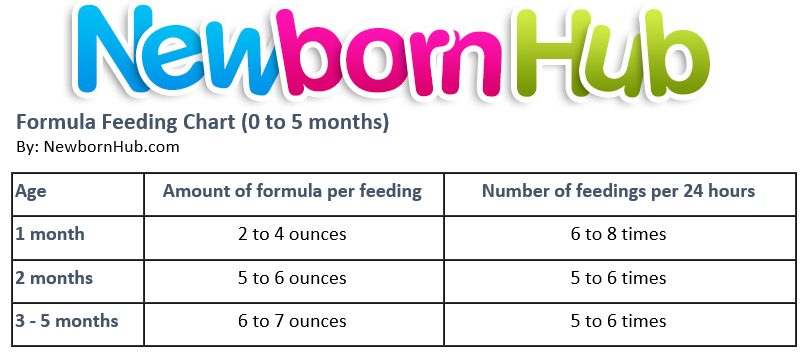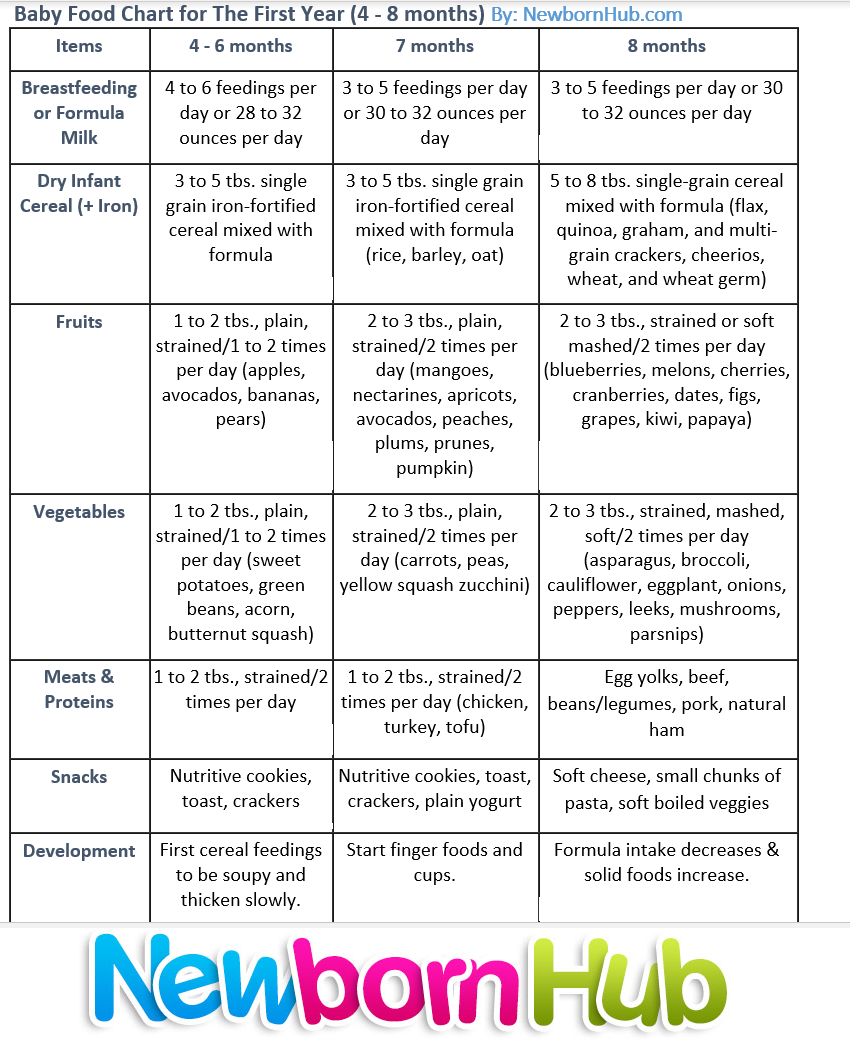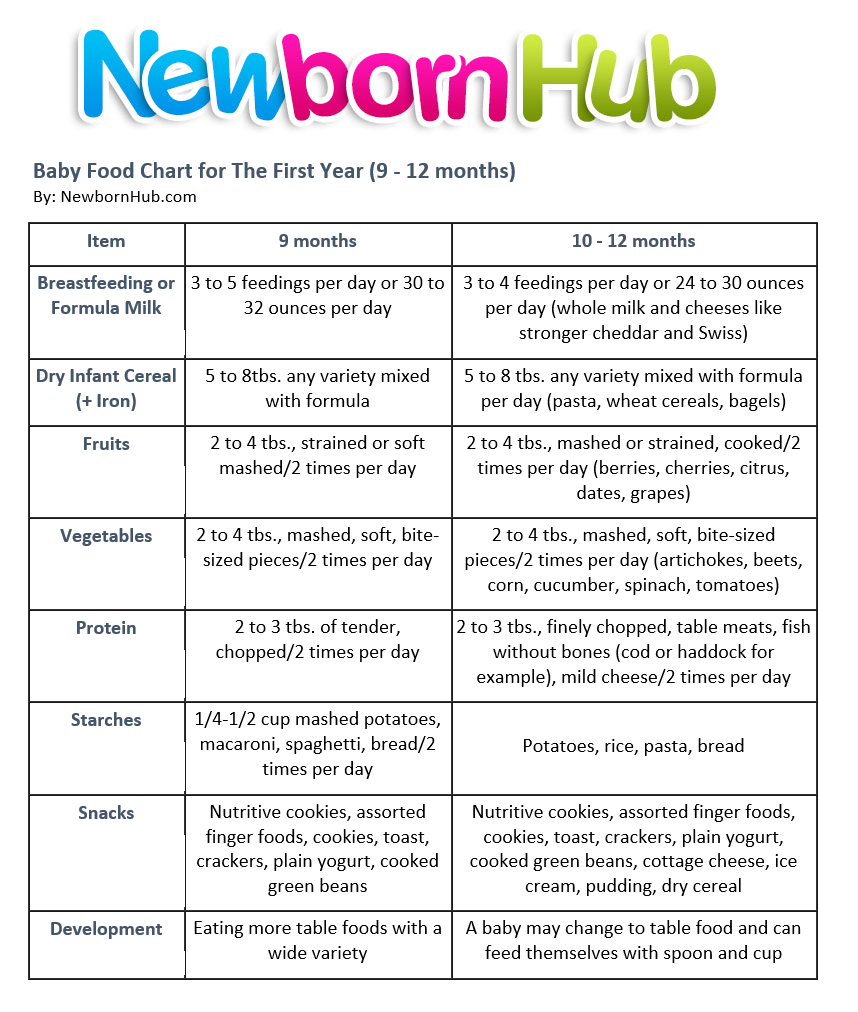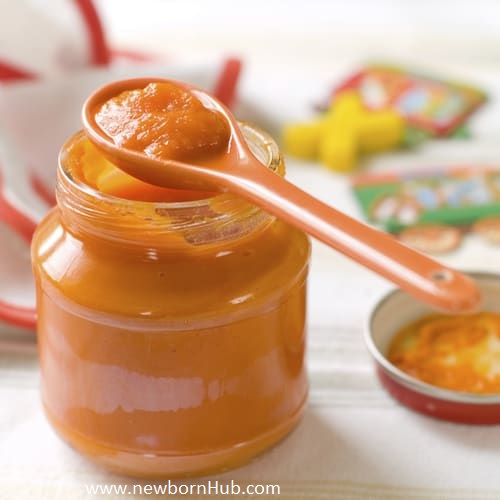- HOME
- Baby Food Chart
Baby Food Chart
Need a baby food chart to know exactly what and when to feed your baby? Making the best food choices for your newborn during their first year is the most important decision you will ever make on their behalf. This will set the tone for the healthy and right kind of food for your baby, for years to come!
The variety of healthy foods that should be consumed by your baby at regular intervals is all the more important, as it is this crucial first year when most of the physical and mental growth occurs for the baby.
You can go directly to your baby's age appropriate food chart from the links below.
- Formula Feeding Chart: 0 - 5 months old
- Baby Food Chart: 4 - 6 months old
- Baby Food Chart: 7 months old
- Baby Food Chart: 8 months old
- Baby Food Chart: 9 months old
- Baby Food Chart: 10 - 12 months old
4 Months Old : Baby Food Chart
Every mom is eager to give their little one solid food when they turn a few months old. They just can’t wait to hop to their new milestone!
Never self-start your baby on solids until you have taken appropriate advice from your child’s healthcare provider. Generally, solid foods should not be given to children until they attain the age of 4 months at least.
During these 4 months, your baby is getting all the adequate nutrients required for them to grow, from the breast milk or formula milk that they are drinking. The little one is not physically mature enough to manage solid food with the help of a spoon. Apart from being hazardous for your child, feeding solid food earlier than 4 months may also lead to over-feeding – meaning an overweight and unhealthy baby at a very early age.
As part of a healthy diet, The American Academy of Pediatrics (AAP) recommends that soon after birth, infants should take a minimum of 400IU of vitamin D per day (in the form of supplements, formula, or cow's milk), to keep at bay, any complications from vitamin D deficiency. Always consult with your pediatrician on the type and amount of vitamin D supplements for your baby.
0 to 5 Months Old : Formula Feeding Chart
If the chart below looks scattered at your mobile device, rotate your device or go directly to the pic of Baby Formula Feeding Chart by clicking here.
Your Baby's Age:
Amount of formula per feeding
Number of feedings per 24 hours

4 - 6 Months Old : Baby Food Chart
If the chart below looks scattered at your mobile device, rotate your device or go directly to the pic for Baby Food Chart (4 - 8 months) by clicking here.
Breastfeeding or Formula Milk :
4 to 6 feedings per day or 28 to 32 ounces per day
Dry Infant Cereal (+ Iron) :
3 to 5 tbs. single grain iron-fortified cereal mixed with formula
Fruits :
1 to 2 tbs., plain, strained/1 to 2 times per day (apples, avocados, bananas, pears)
Vegetables :
1 to 2 tbs., plain, strained/1 to 2 times per day (sweet potatoes, green beans, acorn, butternut squash)
Meats & Proteins :
1 to 2 tbs., strained/2 times per day
Snacks :
Nutritive cookies, toast, crackers
Development :
First cereal feedings to be soupy and thicken slowly.
7 Months Old : Baby Food Chart
If the chart below looks scattered at your mobile device, rotate your device or go directly to the pic for Baby Food Chart (4 - 8 months) by clicking here.
Breastfeeding or Formula milk:
3 to 5 feedings per day or 30 to 32 ounces per day
Dry Infant Cereal (+ Iron) :
3 to 5 tbs. single grain iron-fortified cereal mixed with formula (rice, barley, oat)
Fruits :
2 to 3 tbs., plain, strained/2 times per day (mangoes, nectarines, apricots, avocados, peaches, plums, prunes, pumpkin)
Vegetables :
2 to 3 tbs., plain, strained/2 times per day (carrots, peas, yellow squash zucchini)
Meats & Proteins :
1 to 2 tbs., strained/2 times per day (chicken, turkey, tofu)
Snacks :
Nutritive cookies, toast, crackers, plain yogurt
Development :
Start finger foods and cups.
8 Months Old : Baby Food Chart
If the chart below looks scattered at your mobile device, rotate your device or go directly to the pic for Baby Food Chart (4 - 8 months) by clicking here.
Breastfeeding or Formula milk:
3 to 5 feedings per day or 30 to 32 ounces per day
Dry Infant Cereal (+ Iron) :
5 to 8 tbs. single-grain cereal mixed with formula (flax, quinoa, graham, and multi-grain crackers, cheerios, wheat, and wheat germ)
Fruits :
2 to 3 tbs., strained or soft mashed/2 times per day (blueberries, melons, cherries, cranberries, dates, figs, grapes, kiwi, papaya)
Vegetables :
2 to 3 tbs., strained, mashed, soft/2 times per day (asparagus, broccoli, cauliflower, eggplant, onions, peppers, leeks, mushrooms, parsnips)
Meats & Proteins :
Egg yolks, beef, beans/legumes, pork, natural ham
Snacks :
Soft cheese, small chunks of pasta, soft boiled veggies
Baby's Development :
Formula intake decreases & solid foods increase.

9 Months Old : Baby Food Chart
If the chart below looks scattered at your mobile device, rotate your device or go directly to the pic for Baby Food Chart (9 - 12 months) by clicking here.
Breastfeeding or Formula Milk:
3 to 5 feedings per day or 30 to 32 ounces per day
Dry Infant Cereal (+ Iron):
5 to 8tbs. any variety mixed with formula
Fruits:
2 to 4 tbs., strained or soft mashed/2 times per day
Vegetables:
Protein:
2 to 4 tbs., mashed, soft, bite-sized pieces/2 times per day
2 to 3 tbs. of tender, chopped/2 times per day
Starches:
1/4-1/2 cup mashed potatoes, macaroni, spaghetti, bread/2 times per day
Snacks:
Nutritive cookies, assorted finger foods, cookies, toast, crackers, plain yogurt, cooked green beans
Baby's Development:
Eating more table foods with a wide variety

10 - 12 Months Old : Baby Food Chart
If the chart below looks scattered at your mobile device, rotate your device or go directly to the pic for Baby Food Chart (9 - 12 months) by clicking here.
Breastfeeding or Formula Milk:
3 to 4 feedings per day or 24 to 30 ounces per day (whole milk and cheeses like stronger cheddar and Swiss)
Dry Infant Cereal (+ Iron):
5 to 8 tbs. any variety mixed with formula per day (pasta, wheat cereals, bagels)
Fruits:
2 to 4 tbs., mashed or strained, cooked/2 times per day (berries, cherries, citrus, dates, grapes)
Vegetables:
Protein:
2 to 4 tbs., mashed, soft, bite-sized pieces/2 times per day (artichokes, beets, corn, cucumber, spinach, tomatoes)
2 to 3 tbs., finely chopped, table meats, fish without bones (cod or haddock for example), mild cheese/2 times per day
Starches:
Potatoes, rice, pasta, bread
Snacks:
Nutritive cookies, assorted finger foods, cookies, toast, crackers, plain yogurt, cooked green beans, cottage cheese, ice cream, pudding, dry cereal
Baby's Development:
A baby may change to table food and can feed themselves with spoon and cup
The introduction of solid foods to your baby’s diet is a key milestone. The guidelines and suggestions on this page are meant to be conservative based on a comparison with other guides in the market.

Before you start experimenting with your baby's taste-buds... and her tummy...and your cooking skills, here are some important tips for introducing solid foods to your baby's diet.
Note of caution: always consult your pediatrician before you introduce any new food to your baby. Be vigilant to any food allergies or intolerance that your baby may have and avoid them completely (on a standalone basis or mixed in other food products).
This baby food chart is a general guide that you can keep handy during the first year of your child’s development. I would recommend you print it and keep it safe or stick it on your refrigerator for easy access and reference. Happy feeding!
Return from Baby Food Chart to Homepage.



New! Comments
Have something to say about what you just read? Leave me a comment in the box below :)